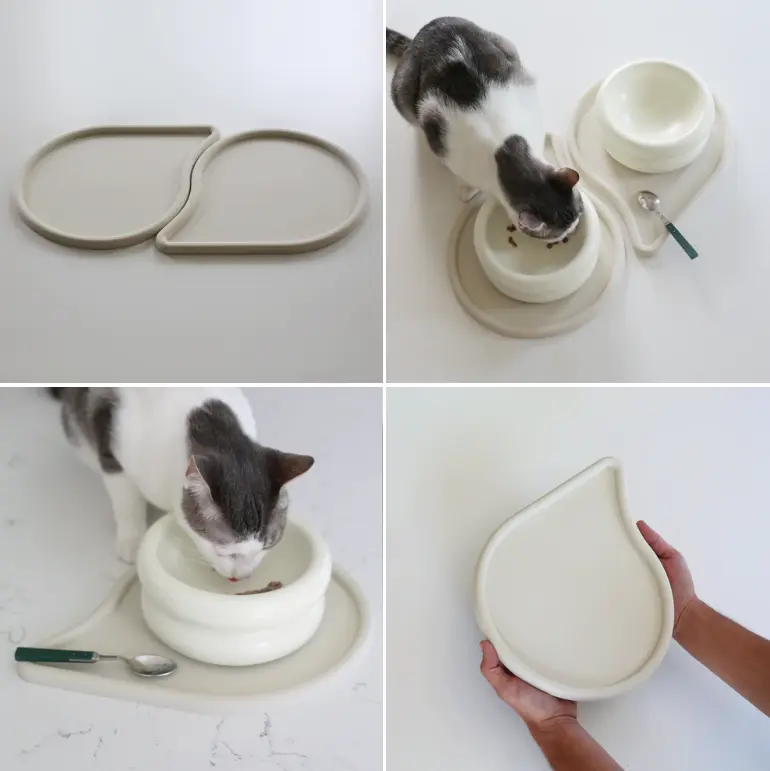Maintaining a clean and tidy feeding area for your cat is essential for promoting good hygiene and preventing unnecessary messes. A thoughtful setup—including both the right bowls and mats—not only helps contain spills and crumbs, but also ensures your cat enjoys a healthy, safe mealtime. Here are eight practical tips to keep your cat’s entire feeding area clean and inviting.
1. Choose Easy-to-Clean Bowls and Mats Start with the right materials. Bowls made from ceramic, stainless steel, or high-quality silicone are generally easier to clean and less likely to harbor bacteria than plastic. Pair them with mats made of silicone or rubber for water resistance and stain prevention. A soft, flexible mat offers comfort, while smooth, non-porous bowls minimize residue buildup. Choosing the right combination makes daily cleanup quicker and more efficient for you—while elevating your cat’s dining experience.
2. Clean Daily, Deep Clean Weekly Wipe down the bowls and mat every day to prevent grime and bacteria from building up. Washing food and water bowls with warm, soapy water once a day is ideal, while a weekly deep clean—soaking and scrubbing both mat and bowls—helps ensure long-term hygiene. Establishing this as part of your daily routine makes it easier to stay on top of. If you have kids, involve them to build responsibility and make cleaning part of a shared pet care ritual.
3. Go for a Slip-Resistant Setup Whether it’s a lightweight bowl or a mat, sliding around during meals can cause spills and stress your cat. Look for a mat with a non-slip base and heavier or rubber-footed bowls to keep everything in place. A stable feeding station encourages calm and focused eating, especially if your cat tends to be an enthusiastic diner. Bonus: fewer spills means less cleanup for you.
4. Vacuum Around the Feeding Area Crumbs and kibble bits often escape the mat or bowl, especially if your cat is a bit messy. Using a handheld vacuum around the feeding zone helps you tackle those stray pieces quickly and thoroughly. Consider dedicating a small vacuum for your pet’s space, stored nearby for convenience. This keeps your cat’s corner crumb-free and your floors cleaner, too.
5. Use Pet-Safe Cleaning Products Whether you’re wiping down a bowl, mat, or the surrounding floor, always opt for pet-safe cleaners. Avoid harsh chemicals—natural solutions like vinegar and baking soda can be just as effective and much safer. Be sure to rinse thoroughly, even with non-toxic options, to avoid any residue that could irritate your cat or affect their food and water.
6. Switch Up the Feeding Spot Occasionally Rotating your cat’s feeding location every few weeks can prevent bacteria buildup in one specific area. It also gives you a chance to do a deeper clean where the bowls and mat usually sit. This change can stimulate your cat’s curiosity and prevent boredom, while also helping you notice things like lingering odors or damage that might otherwise go unnoticed.
7. Keep Cleaning Supplies Close at Hand Create a mini cleaning station near your pet’s feeding area. Stock it with essentials like paper towels, wipes, a spray bottle of pet-safe cleaner, and a sponge or dish brush. Having everything nearby makes it easy to quickly address spills and stay on top of maintenance. The less friction between mess and cleanup, the more likely you’ll do it consistently.
8. Check Bowls and Mats for Wear and Tear Just like any well-loved item, bowls and mats don’t last forever. Inspect them regularly for cracks, warping, fraying, or signs of mold. Bowls with scratches or chips can harbor bacteria, while aging mats might lose their grip or become harder to clean. Replacing worn-out items when needed helps keep the feeding area safe and hygienic—and ensures your cat always dines in comfort.
Final Thoughts A clean feeding space isn’t just about aesthetics—it’s about your cat’s health, comfort, and well-being. With the right setup and a few consistent habits, you can create an environment that both you and your cat appreciate every day.


